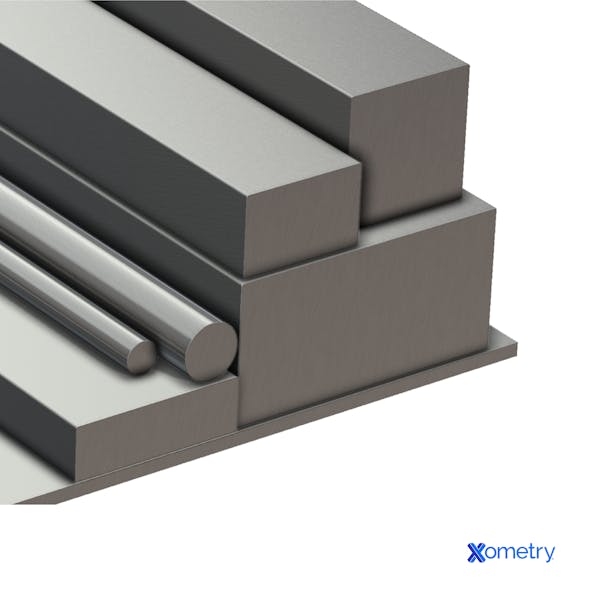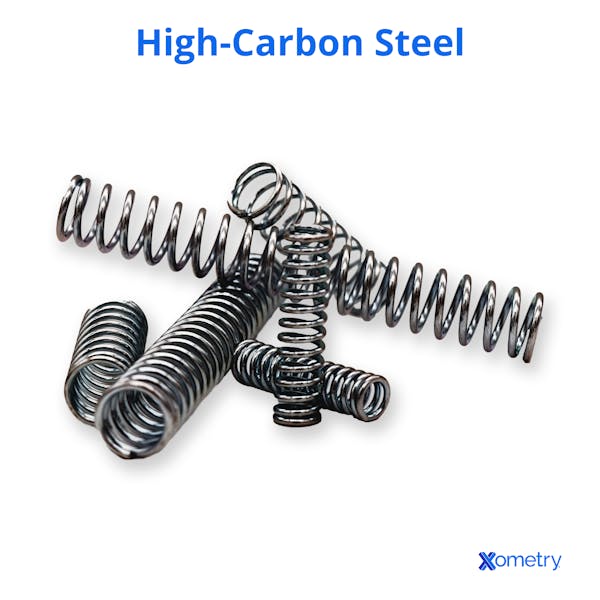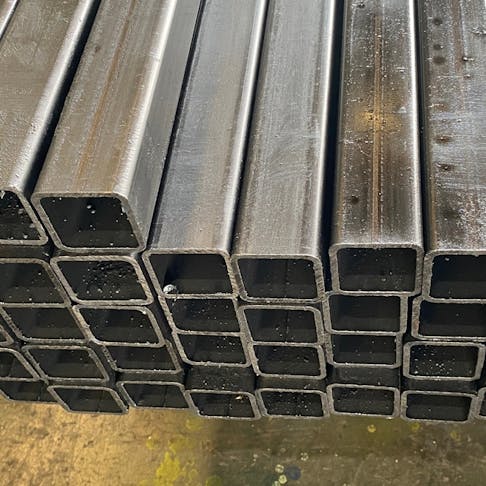It will come as no surprise that there’s a lot of carbon in high-carbon steel, and it’s exactly that which makes this metal extra strong, hard, brittle, and wear- and corrosion-resistant. It’s not likely to break under pressure, and is considered great value for money. Let’s look at what this steel type is, how it’s made, what its properties are, and how else it is used in industry by many Xometry customers and other designers and engineers.
What is High-Carbon Steel?
Also known as carbon tool steel, or M2, high-carbon steel refers to any steel with a carbon content of over 0.6%. Any lower than that, then it falls into the medium- or low-carbon category. If it’s higher than 1.0%, it belongs to the ultra-high-carbon steel group. This type of steel has a very simple composition: in addition to the 0.60–1.00% carbon, it’s made up of just 98.1–99.1% iron, and 0.30–0.90% manganese.

Like other steel types, high-carbon steel is made by melting either recycled steel or pig iron to remove impurities, and then adding the alloying elements before casting or extruding. Molten steel, by nature, dissolves carbon at high temperatures, but will typically release it if it is allowed to cool slowly. So as not to allow the carbon to escape the metal’s lattice structure, the metal is quenched (rapidly cooled) to increase the cooling rate from about 200°C to 1000°C per minute. This retains all the internal stresses in the microstructure—although “internal stress” sounds like a bad thing, it’s not—in this case, it improves the steel’s strength and hardness.
Carbon steel is commonly used to make a wide variety of appliances, toys, tools (i.e. knives, swords, shears, etc.), gear wheels, chains, and hardware like nails, fasteners, drill bits, and springs (pictured below).

Although it’s sometimes confused with stainless steel because they both have a high carbon content, these two steels are quite different. Stainless steel has at least 10.5% chromium in it, while high-carbon steel can have just a little, or none at all. The high chromium in stainless steel makes it corrosion-resistant, and this is perhaps the main differentiating factor as high-carbon steel can rust a lot more easily. While a high carbon content offers this steel an array of benefits (it also has more tensile strength than stainless steel), it also gives it low ductility and malleability, and makes it hard to weld, cut, and form.
Properties
The below table lists out high-carbon steel’s properties, including physical and thermal.
| Property | AISI 1060 | AISI 52100 |
|---|---|---|
Property Density | AISI 1060 7.85 g/cm² | AISI 52100 7.81 g/cm² |
Property Yield strength | AISI 1060 485 MPa | AISI 52100 2033 MPa |
Property Hardness (Rockwell B) | AISI 1060 89 | AISI 52100 64 |
Property Magnetism (Curie point) | AISI 1060 770ºC | AISI 52100 770ºC |
Property Machinability rating | AISI 1060 45–57% (varies*) | AISI 52100 50% |
Property Melting point | AISI 1060 1540–1590ºC | AISI 52100 1424–1460ºC |
Property Thermal conductivity | AISI 1060 19.0–52.0 W/m⦁K | AISI 52100 46.6 W/m⦁K |
Property Coefficient of thermal expansion | AISI 1060 9.9–14.8 µm/m⦁ºC | AISI 52100 12.3 µm/m⦁ºC |
Property Specific heat capacity | AISI 1060 0.410–0669 J/g⦁ºC | AISI 52100 0.460 J/g⦁ºC |
*E.g. 1095 steel has 0.95% carbon and a 45% machinability rating, while grade 1060 steel has 0.6% carbon and a machinability rating of 57%.
Types of High-Carbon Steel
The four main high-carbon steel categories are explained below.
Alloyed: Other elements, like chromium, cobalt, manganese, molybdenum, nickel, tungsten, and/or vanadium, are sometimes added to steel to improve its hardness, strength, toughness, heat- and corrosion resistance. These extra ingredients will also raise the material’s price, so it’s typically only done when absolutely necessary. A common example of an alloyed high-carbon steel is stainless steel.
Spring steel: This type has a carbon content of 0.6–1.0%, and it sometimes has varying amounts of other alloying elements. Most importantly, spring steel has silicon which gives it a high yield strength, and makes it flexible—hence the bouncy name.
Plain carbon steel: As the Plain Jane of steel, this type doesn’t have any other alloying elements (well, none of significance, anyway). It's hard to weld, fails after minimal elongation, and is sensitive to heat treatments, but, on the bright side, it is the cheapest form of high-carbon steel.
Tool steel: Alloyed with tungsten, molybdenum, cobalt, and vanadium, tool steel is extra durable—which is just as well since it’s used to make tools—and it has excellent heat resistance so won’t temper in high temperatures.
High-Carbon Steel Forms
High-carbon steel comes in quite a few forms, each of which could have a different microstructure and characteristics that would make it better for a certain application than another. They do, however, have a very similar chemical composition. The most common high-carbon steel forms are described below.
Hot-rolled: The hot-rolling process is done near the recrystallization temperature, something that creates finer grains in the steel’s microstructure that are more prone to dislocation, making this form less strong than others. It also has fewer residual internal stresses which makes it less hard than its cold-rolled counterpart, and, since it shrinks as it cools, its dimensions are rather hard to control. It is, however, a more affordable option thanks to its low energy needs, so it’s used in applications that aren’t too strict on tolerances, like construction and rail.
Cold-rolled: This form of steel, although less ductile than hot-rolled, is harder with a better surface finish, and more dimensional accuracy. In the cold rolling process, which is done at room temperature, the metal’s grains are elongated to strain-harden the material. Stressing and relieving the steel before use is a must otherwise it could warp. This type is used a lot to make electric motors, water heaters, frying pans, and pressure vessels.
Tempered: Tempering involves reheating the steel to just below its eutectoid point, allowing the carbon to dissolve in the lattice structure, and then quenching it to trap the carbon. Its altered crystal lattice, martensite, makes the steel stronger and harder, which is why you’ll find tempered steel in a lot of construction equipment and tools.
Equivalent Grades
There are many different grades of high-carbon steel which differ mainly in their carbon content, and the names of these steels can be different in various countries. We list some of the equivalent names, using the 1060 grade as an example.
| Country | Grade |
|---|---|
Country European Norm | Grade C60 |
Country Germany | Grade C60 |
Country England | Grade 070M60 |
Country Italy | Grade 1C60 |
Country Japan | Grade S58C |
Country China | Grade 60 |
Country Russia | Grade 60 |
How Xometry Can Help
We hope you found our article helpful in learning all about high-carbon steel and how it can be used, but for any more information or relevant services, please reach out to one of our representatives. You can also head on over to the Xometry Instant Quoting Engine® for a free, no-obligation quote on dozens of materials.
Disclaimer
The content appearing on this webpage is for informational purposes only. Xometry makes no representation or warranty of any kind, be it expressed or implied, as to the accuracy, completeness, or validity of the information. Any performance parameters, geometric tolerances, specific design features, quality and types of materials, or processes should not be inferred to represent what will be delivered by third-party suppliers or manufacturers through Xometry’s network. Buyers seeking quotes for parts are responsible for defining the specific requirements for those parts. Please refer to our terms and conditions for more information.


